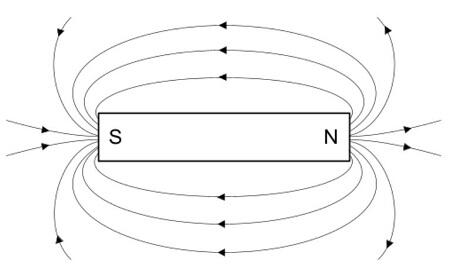Chapters
Have you ever wondered how we can make sense of something we can't see? Magnetic fields, which surround magnets and electric currents, are one such invisible phenomenon. However, there is a clever way to unlock their secrets: magnetic field lines. In this article, we will explore what magnetic field lines are, how they show us the direction of magnetic fields, and why they are essential in helping us visualise these hidden forces. Get ready to embark on a journey where the unseen becomes visible as we unravel the magic of magnetic field lines.

Magnetic Field Lines
Magnetism and electromagnetism play a crucial role in physics, and they arise due to the presence of magnetic fields around magnets and electric currents. These fields can be explored by examining their forces on magnets and magnetic materials. We can define the magnetic field as:
"When a magnet or an electric current is present, it generates an invisible force field called a magnetic field"
OR
"An area around the magnet where a force is exerted on another magnet or on a magnetic material is known as magnetic field"
This field surrounds the magnet or the current-carrying wire and influences the behaviour of other magnets and magnetic materials in its vicinity.
We can observe the forces they exert on magnets and magnetic materials to investigate magnetic fields. For example, when bringing a magnet close to another magnet or a piece of iron, you may notice a force of attraction or repulsion between them. This behaviour is a result of the interaction of their magnetic fields.
Similarly, if an electric current flows through a wire, it creates a magnetic field around it. This can be observed by using a compass needle. When the compass is placed near the current-carrying wire, the needle aligns with the magnetic field and deflects from its original position. This deflection is due to the magnetic field produced by the electric current.
By investigating these forces and interactions, we can gain insights into the nature of magnetic fields. We can observe how the strength and direction of the magnetic field influence the behaviour of magnets and magnetic materials. This knowledge is essential in various applications, such as designing electric motors, generators, and transformers and understanding the Earth's magnetic field and its impact on navigation.
How to Detect Magnetic Field?
Even though magnetic fields are invisible, we can find them using a unique magnetic compass tool. A compass has a little bar magnet that can move around. It shows us the direction of the Earth's magnetic field or the magnetic field of a magnet.
We can make a map of magnetic fields using small compasses:
- Put the compass close to the magnet on a piece of paper.
- Mark the way the compass needle points.
- Move the compass to different spots in the magnetic field and mark the needle direction each time.
- Connect the marks to create lines that show the field.
The needle of a compass points to the south pole of the magnet.
How a compass acts tells us that the Earth has a particular magnetic field. The Earth's magnetic field is created by its core, which is made up of iron and nickel.

Direction of Magnetic Field Lines Using Magnetic Field Diagram
When we draw a picture of a magnetic field around a bar magnet, we can see some essential things:
- The lines representing the magnetic field never cross each other.
- If the lines are closer, the magnetic field is stronger in that area.
- The lines have little arrows, which show the direction of the force on a magnetic north pole.
- The arrowheads on the lines point from the magnet's north pole to its south pole.
Right-hand Grip Rule
The magnetic field around a wire with an electric current is like a circle around the wire. This field can move the needle of a magnetic compass. The field is stronger if you're closer to the wire and gets stronger if the current gets stronger. You can find the direction of the current and the magnetic field using the "right-hand grip rule." Curl your right-hand fingers as if holding bicycle handlebars, and point your thumb away from your hand. Your thumb shows the current's direction, and your fingers show the magnetic field's direction.
Solenoids
A solenoid is a wire that's coiled up like a spiral. When there's an electric current, the solenoid acts like a magnet. The magnetic field shape is similar to that of a bar magnet.
Inside a solenoid, the magnetic field is strong and the same everywhere. The small magnetic fields from each coil add up and make a stronger overall field. The tiny magnetic fields cancel each other outside the solenoid, so the field is much weaker. Electromagnets are used in things like remote-controlled door locks and electric bells.
Use of Magnetic Field Lines in Visualising Magnetic Fields
Magnetic field lines are used as a visual tool to understand and visualise magnetic fields. They provide a graphical representation of the field's strength, direction, and pattern, aiding in analysing magnetic phenomena and their practical applications. Here are some critical uses of magnetic field lines in this context:
- Representation of Field Strength: Magnetic field lines provide a visual representation of the strength of a magnetic field. The density of field lines indicates the relative strength of the lot at different points. A greater density of lines indicates a stronger magnetic field, while a sparser distribution of lines suggests a weaker field.
- The direction of the Field: The orientation of magnetic field lines represents the direction of the magnetic field at any given point. Following the lines, we can determine the path a small compass or magnetic material would take if placed in the area. This helps us understand the direction of the magnetic force and how magnets interact with each other or with other objects.
- Visualisation of Magnetic Field Patterns: Magnetic field lines allow us to visualise and understand the shape and pattern of magnetic fields. For example, the field lines spread out around a bar magnet from the north pole and curve back into the south pole. By mapping and drawing these lines, we can create visual representations of magnetic field patterns, aiding in understanding the field's behaviour.
- Analysis of Magnetic Phenomena: Magnetic field lines help us analyse various magnetic phenomena. For instance, they can be used to study the behaviour of a magnetic field around a current-carrying wire or the interaction between magnets. Observing the pattern and behaviour of the field lines allows us to gain insights into how magnetic fields influence objects and magnetic sources.












You are the best,, coz you have gotten content about the topics
Hello ! Glad to hear that you’ve found the content useful!